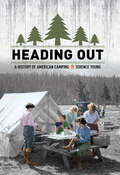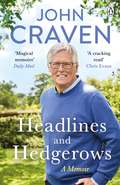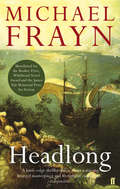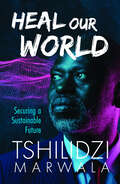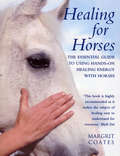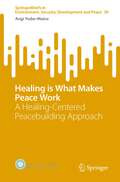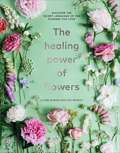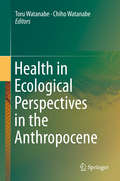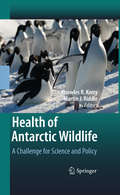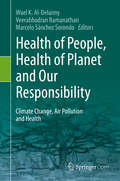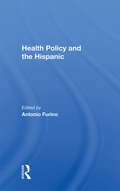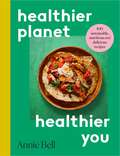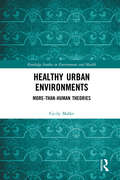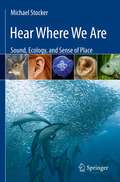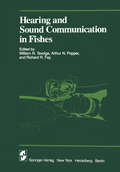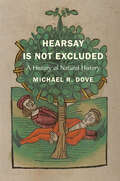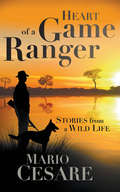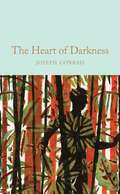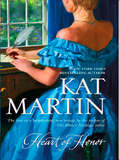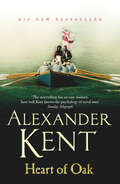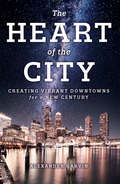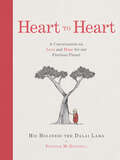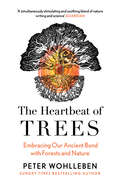- Table View
- List View
Heading Out: A History of American Camping
by Terence YoungWho are the real campers? Through-hiking backpackers traversing the Appalachian Trail? The family in an SUV making a tour of national parks and sleeping in tents at campgrounds? People committed to the RV lifestyle who move their homes from state to state as season and whim dictate? Terence Young would say: all of the above. Camping is one of the country's most popular pastimes—tens of millions of Americans go camping every year. Whether on foot, on horseback, or in RVs, campers have been enjoying themselves for well more than a century, during which time camping’s appeal has shifted and evolved. In Heading Out, Young takes readers into nature and explores with them the history of camping in the United States.Young shows how camping progressed from an impulse among city-dwellers to seek temporary retreat from their exhausting everyday surroundings to a form of recreation so popular that an industry grew up around it to provide an endless supply of ever-lighter and more convenient gear. Young humanizes camping’s history by spotlighting key figures in its development and a sampling of the campers and the variety of their excursions. Readers will meet William H. H. Murray, who launched a craze for camping in 1869; Mary Bedell, who car camped around America for 12,000 miles in 1922; William Trent Jr., who struggled to end racial segregation in national park campgrounds before World War II; and Carolyn Patterson, who worked with the U.S. Department of State in the 1960s and 1970s to introduce foreign service personnel to the "real" America through trailer camping. These and many additional characters give readers a reason to don a headlamp, pull up a chair beside the campfire, and discover the invigorating and refreshing history of sleeping under the stars.
Headlines and Hedgerows: A Memoir
by John CravenDiscover the first and only memoir from national treasure John Craven, as he recounts both the highs and the lows of one of the longest entertaining careers in history, and the people, family and animals that have shaped it.'Magical memoirs. A BBC legend. A broadcasting icon. The best bits from cub reporter to Countryfile . . . his early career sounds like a riot' Mail on SundayBorn in Leeds, John showed an early interest in newspapers when, aged eleven, he wrote the 'Grimthorpe Street Gazette': a one-page paper detailing the latest goings-on in his street. It was a short-lived enterprise, not least as he only had one copy of it - which he charged neighbours a penny to borrow and read.But it was while working as a journalist at the Yorkshire Post that he heard of a new opening at the BBC - a move that was to change his life forever... Throughout the 1970s and 80s, John was, to children and parents alike, a friendly guide to the big wide world through Newsround, making news accessible for everyone. Since then, having presented Countryfile from across the breadth of Britain for 30 years, John has introduced us to the people, landscapes and animals which make it so special.He has been telling the story of Britain since 1970, and now you can read the story of his own life in this entertaining memoir.
Headlong: A Novel
by Michael FraynShortlisted for the Man Booker Prize Headlong begins when Martin Clay, a young would-be art historian, believes he has discovered a missing masterpiece. The owner of the painting is oblivious to its potential and asks Martin to help him sell it, leaving Martin with the chance of a lifetime: if he could only separate the painter from its owner, he would be able to perform a great public service, to make his professional reputation, perhaps even rather a lot of money as well. But is the painting really what Martin believes it to be? As Martin is drawn further into this moral and intellectual labyrinth, events start to spiral out of control . . . Shortlisted for the Man Booker Prize, Whitbread Novel Award and the James Tait Black Memorial Prize for fiction, Headlong is an ingeniously comic thriller that follows a young philosophy lectuerer's obsessive race through the art world in search of an elusive masterpiece. Michael Frayn's other novels include Spies, which won the Whitbread Best Novel award, and Skios, which was longlisted for the Booker Prize.
Heal our World: Securing a Sustainable Future
by Tshilidzi MarwalaThe world is emerging from the COVID-19 pandemic, more fragmented and further away from the more equal and equitable iteration imagined in 2015 when the Sustainable Development Goals (SDGs) were conceptualised.As we hurtle at seemingly lightning speed towards the 2030 deadline to achieve these goals, the urgency is palpable. Although we have certainly strayed further away from the targets, there is still time to act in order to ensure that we inch closer to this vision.Professor Tshilidzi Marwala paints a stark, and often grim, picture of our current context, one defined by monumental setbacks in the SDGs. Yet, as he carves out each developmental goal and its implications, it is apparent that there are tangible solutions that can be implemented now.Tshilidzi’s assertion that now is the time to act is backed by intricate and actionable data with a simple mission statement: we must heal the future.He offers a new narrative that addresses how we can translate the latent potential that exists through technology, innovation and Fourth Industrial Revolution approaches to leadership and policy making to deal with, among others, corruption, poverty eradication, joblessness, an education system in crisis, declining economies and food insecurity.Heal our World is a deep dive into the SDGs, particularly in the African context, and it looks toward securing a future in which our divisions are blurred, and our goals seem almost in reach again.Tshilidzi Marwala, the author of Heal our World, Leading in the 21st Century and Leadership Lessons from Books I Have Read is the Vice-Chancellor and Principal of the University of Johannesburg. From 1 March 2023, he will be the Rector of the United Nations University based in Tokyo, Japan. He was previously Deputy Vice-Chancellor for Research and Executive Dean of the Faculty of Engineering at the University of Johannesburg and Full Professor at the Carl & Emily Fuchs Chair of Systems and Control Engineering at the University of the Witwatersrand.Tshilidzi holds a Bachelor of Science in Mechanical Engineering (magna cum laude) from Case Western Reserve University, a PhD in Artificial Intelligence from the University of Cambridge and a Post-Doc at Imperial College (London). He is a member of the American Academy of Arts and Sciences, The World Academy of Sciences (TWAS), the Academy of Science of South Africa (ASSAf), the African Academy of Sciences (AAS) and the South African Academy of Engineering (SAAE). He is a distinguished member of the Association for Computing Machinery (ACM). His research interests are multidisciplinary and include the theory and application of artificial intelligence to engineering, computer science, finance, social science and medicine.He has supervised 37 doctoral students. He has also published 23 books on artificial intelligence (one translated into Chinese) and over 300 papers in journals, proceedings, book chapters and magazines. He holds five international patents.
Healing For Horses
by Margrit CoatesHealing for Horses is the most comprehensive guide available on the subject of using healing energy with horses. In this book, the world’s leading animal healer, explains what healing is, how it works and how it helps in the context of horses. Margrit Coates gives practical guidance on how you can learn the skill yourself, when and where to do it, together with 'dos and don'ts'. Margrit also describes the way energy runs through a living being, what and where the chakras are on horses, and how healing can benefit horses and improve the horse-human bond. Included are many fascinating case histories of horses who have been sick, depressed, injured, traumatised or terminally ill, with detailed descriptions of how healing has helped them all. Packed full of tips, photos, illustrations and guidelines, Healing for Horses is an essential book for every horse lover, as well as those of us who work with horses in any capacity way.
Healing is What Makes Peace Work: A Healing-Centered Peacebuilding Approach (SpringerBriefs in Environment, Security, Development and Peace #39)
by Angi Yoder-MainaThe book goes beyond mental health and psychosocial support (MHPSS) to a holistic approach centered on healing. The book lays at the intersection of peacebuilding, global mental health, and development. In many parts of the world, entire generations live in chronic violence—just surviving. The exposure to violence has long-lasting effects which are not well accounted for in conflict analysis, stabilization efforts, peacebuilding, and governance initiatives. Extreme exposure to violence, abuse, neglect, and marginalization negatively affects levels of resilience and the ability of affecting the transition from violence to peace. A healing-centered peacebuilding approach requires fundamental changes in how systems are designed, organizations function, and practitioners engage with people, their communities, and their institutions. Key elements of the practice-based approach included inclusion, customization and contextualization, breaking cycles of violence, systems thinking, and trauma-informed tools. The approach considers emotional distress to be a critical variable in violent conflict and instability. Trauma is not only a consequence of violence, but also a cause of instability.
The Healing Power of Flowers: discover the secret language of the flowers you love
by Claire BowenLive life in full bloom.This beautiful book features your favourite flowers grouped by their purpose – for love, for joy, for luck, for calm, to console, and to celebrate. Discover their traditional meanings, holistic benefits, and when flowers are in season so that they can be sourced locally with a minimal carbon footprint. By creating thoughtful personal bouquets or choosing a flower for its meaning, its natural energy, or holistic property, you can bring the benefits of the natural world back into your home, your workplace, and into the lives of loved ones. Find out why you should give Foxgloves to celebrate a new job, Lilacs for joy, or Chrysanthemums for luck, and become fluent in the secret language of flowers.
Health in Ecological Perspectives in the Anthropocene
by Toru Watanabe Chiho WatanabeThis book focuses on the emerging health issues due to climate change, particularly emphasizing the situation in developing countries. Thanks to recent development in the areas of remote sensing, GIS technology, and downscale modeling of climate, it has now become possible to depict and predict the relationship between environmental factors and health-related event data with a meaningful spatial and temporal scale. The chapters address new aspects of environment-health relationship relevant to this smaller scale analyses, including how considering people’s mobility changes the exposure profile to certain environmental factors, how considering behavioral characteristics is important in predicting diarrhea risks after urban flood, and how small-scale land use patterns will affect the risk of infection by certain parasites, and subtle topography of the land profile. Through the combination of reviews and case studies, the reader would be able to learn how the issues of health and climate/social changes can be addressed using available technology and datasets. The post-2015 UN agenda has just put forward, and tremendous efforts have been started to develop and establish appropriate indicators to achieve the SDG goals. This book will also serve as a useful guide for creating such an indicator associated with health and planning, in line with the Ecohealth concept, the major tone of this book. With the increasing and pressing needs for adaptation to climate change, as well as societal change, this would be a very timely publication in this trans-disciplinary field.
Health of Antarctic Wildlife: A Challenge for Science and Policy
by Knowles R. Kerry Martin Riddlecomprehensively up to date. We are most grateful to these authors and to those we recruited to write the additional chapters necessary to fill the significant gaps. We acknowledge also the sacrifice of some who presented results of original research and have thus suffered a longer time than usual to publication. The timing of publication however has provided the opportunity to highlight recent discussions and resolutions made within the Antarctic Treaty forum to protect wildlife against disease and to include responses by Government and non-Government operators in Antarctica. These developments mostly followed from the Workshop on Diseases of Antarctic Wildlife. The book comprises 17 chapters presented in two parts. Wildlife disease consists of reviews, case studies and health assessments, and External factors covers the environmental, administrative and legal aspects. Each chapter is complete and c- tains all references. Six important documents are provided as Appendices. These present methods, reviews and other documents which are referred to in one or more chapters but are not readily available. There are many related topics we have been unable to cover that would enhance the understanding of health and disease processes in Antarctica. While we ackno- edge their importance they are outside the scope of the present volume. Such topics include epidemiology, new and emerging infectious diseases and the effects of climate change. These topics are referred to in the various chapters where ref- ences to source material are given.
Health of People, Health of Planet and Our Responsibility: Climate Change, Air Pollution and Health
by Wael K. Al-Delaimy Veerabhadran Ramanathan Marcelo Sánchez SorondoThis open access book not only describes the challenges of climate disruption, but also presents solutions. The challenges described include air pollution, climate change, extreme weather, and related health impacts that range from heat stress, vector-borne diseases, food and water insecurity and chronic diseases to malnutrition and mental well-being.The influence of humans on climate change has been established through extensive published evidence and reports. However, the connections between climate change, the health of the planet and the impact on human health have not received the same level of attention. Therefore, the global focus on the public health impacts of climate change is a relatively recent area of interest. This focus is timely since scientists have concluded that changes in climate have led to new weather extremes such as floods, storms, heat waves, droughts and fires, in turn leading to more than 600,000 deaths and the displacement of nearly 4 billion people in the last 20 years. Previous work on the health impacts of climate change was limited mostly to epidemiologic approaches and outcomes and focused less on multidisciplinary, multi-faceted collaborations between physical scientists, public health researchers and policy makers. Further, there was little attention paid to faith-based and ethical approaches to the problem. The solutions and actions we explore in this book engage diverse sectors of civil society, faith leadership, and political leadership, all oriented by ethics, advocacy, and policy with a special focus on poor and vulnerable populations. The book highlights areas we think will resonate broadly with the public, faith leaders, researchers and students across disciplines including the humanities, and policy makers.
Health Policy/spec Sale/avail Hard Only
by Antonio FurinoExploring the many dimensions of Hispanic health issues, this book updates interested readers with recent information and offers a view of the depth, scope, and complementarity of the challenges of providing adequate health care. Accordingly, the book is organized in four sections addressing, first, the conceptual, institutional, and policy element
Health Policy/spec Sale/avail Hard Only
by Antonio FurinoExploring the many dimensions of Hispanic health issues, this book updates interested readers with recent information and offers a view of the depth, scope, and complementarity of the challenges of providing adequate health care. Accordingly, the book is organized in four sections addressing, first, the conceptual, institutional, and policy element
Healthier Planet, Healthier You: 100 Sustainable, Nutritious and Delicious Recipes
by Annie Bell'A powerful book that will help you create positive planetary change from the pleasure of your own kitchen! - Eco-Chef Tom Hunt, author of Eating for Pleasure, People and Planet'A most thoughtful, caring and considered book.' Jeremy Lee, head chef at Quo VadisWhat if you could eat more healthily and live more sustainably – without cutting out meat or dairy?Award-winning recipe writer and registered nutritionist Annie Bell shows how you can minimize your impact on the environment AND boost your health.Packed with 100 delicious recipes, Healthier Planet, Healthier You is a simple, evidence-based blueprint that brings together the small changes that will make a lasting difference to your health and the planet.The mouthwatering recipe collection is inspired by the principles of the Planetary Health Diet, a greener way of eating informed by globally agreed scientific targets aimed at tackling climate change. This flexible approach includes simple swaps that mean all diets are catered for, whether you’re vegetarian or vegan, pescatarian or flexitarian.These nutritious, tasty recipes are simple to make, use easy-to-find ingredients, and crucially offer an affordable way of eating. Including practical tips to reduce food waste and a 28-day plan to get you started, Healthier Planet, Healthier You makes it easier than ever to enjoy healthy, sustainable food every day.First published in black and white hardback as Eat to Save the Planet, this beautifully photographed full-colour paperback shows how everyone can eat in a healthy, climate-conscious way, while still enjoying every bite.
Healthy Urban Environments: More-than-Human Theories (Routledge Studies in Environment and Health)
by Cecily MallerSet in the ‘human–environment’ interaction space, this book applies new theoretical and practical insights to understanding what makes healthy urban environments. It stems from recognition that the world is rapidly urbanising and the international concern with how to create healthy settings and liveable cities in the context of a rapidly changing planet. A key argument is that usual attempts to make healthy cities are limited by human-centrism and bifurcated, western thinking about cities, health and nature. Drawing on the innovative ‘more-than-human’ scholarship from a range of disciplines, it presents a synthesis of the main contributions, and how they can be used to rethink what healthy urban environments are, and who they are for. In particular, the book turns its attention to urban biodiversity and the many non-human species that live in, make and share cities with humans. The book will be of interest to scholars and students in human geography, health sociology, environmental humanities, public health, health promotion, planning and urban design, as well as policymakers and professionals working in these fields.
Healthy Urban Environments: More-than-Human Theories (Routledge Studies in Environment and Health)
by Cecily MallerSet in the ‘human–environment’ interaction space, this book applies new theoretical and practical insights to understanding what makes healthy urban environments. It stems from recognition that the world is rapidly urbanising and the international concern with how to create healthy settings and liveable cities in the context of a rapidly changing planet. A key argument is that usual attempts to make healthy cities are limited by human-centrism and bifurcated, western thinking about cities, health and nature. Drawing on the innovative ‘more-than-human’ scholarship from a range of disciplines, it presents a synthesis of the main contributions, and how they can be used to rethink what healthy urban environments are, and who they are for. In particular, the book turns its attention to urban biodiversity and the many non-human species that live in, make and share cities with humans. The book will be of interest to scholars and students in human geography, health sociology, environmental humanities, public health, health promotion, planning and urban design, as well as policymakers and professionals working in these fields.
Hear Where We Are: Sound, Ecology, and Sense of Place
by Michael StockerThroughout history, hearing and sound perception have been typically framed in the context of how sound conveys information and how that information influences the listener. "Hear Where We Are" inverts this premise and examines how humans and other hearing animals use sound to establish acoustical relationships with their surroundings. This simple inversion reveals a panoply of possibilities by which we can re-evaluate how hearing animals use, produce, and perceive sound. Nuance in vocalizations become signals of enticement or boundary setting; silence becomes a field ripe in auditory possibilities; predator/prey relationships are infused with acoustic deception, and sounds that have been considered territorial cues become the fabric of cooperative acoustical communities. This inversion also expands the context of sound perception into a larger perspective that centers on biological adaptation within acoustic habitats. Here, the rapid synchronized flight patterns of flocking birds and the tight maneuvering of schooling fish becomes an acoustic engagement. Likewise, when stridulating crickets synchronize their summer evening chirrups, it has more to do with the ‘cricket community’ monitoring their collective boundaries rather than individual crickets establishing ‘personal’ territory or breeding fitness. In "Hear Where We Are" the author continuously challenges many of the bio-acoustic orthodoxies, reframing the entire inquiry into sound perception and communication. By moving beyond our common assumptions, many of the mysteries of acoustical behavior become revealed, exposing a fresh and fertile panorama of acoustical experience and adaptation.
Hearing and Sound Communication in Fishes (Proceedings in Life Sciences)
by W. N. Tavolga A. N. Popper R. R. FayThis volume is a compilation of the papers presented at a meeting that took place in April 1980 at the Mote Marine Laboratory, Sarasota, Florida. The meeting and this volume are outgrowths of two earlier international meetings on marine bio-acoustics that occurred in 1963 and 1966 (Tavolga 1964, 1967). The first meeting took place at the Lerner Marine Laboratory of the American Museum of Natural History, while the second meeting was at the American Museum itself, and was under the sponsorship of the Department of Animal Behavior. It is apparent that these two volumes have had immense impact on the current study of marine bio-acoustics, and particularly on fish audition. In a preliminary conference in Sarasota in 1979 we decided that it was time for another such meeting, to bring together as many as possible of the investigators interested in fish acoustics in order to assess the current state of our knowledge and predict directions for research for the next several years. Such a meeting appeared par ticularly timely, since over the past four or five years there have been many new studies that have provided new empirical and theoretical work on basic mechanisms of fish audition. Furthermore, it became evident, as we made up preliminary lists of possible participants, that few of the currently active workers were in the field back in 1966. In fact, of the current participants, only Drs.
Hearsay Is Not Excluded: A History of Natural History (Yale Agrarian Studies Series)
by Michael R. DoveThis chronicle of natural history argues that the modern environmental crisis and rise in science skepticism codeveloped with the rise of ever narrower scientific disciplines For millennia, the field of natural history promoted a knowledgeable and unifying view of the world. In contrast, the modern rise of narrow scientific disciplines has promoted a dichotomy between nature and culture on the one hand and between scientific and folk knowledge on the other. Drawing on the fields of anthropology, history, and environmental science, Michael R. Dove argues that the loss of this historic holistic vision of the world is partly to blame for contemporary environmental degradation and science skepticism. Dove bases this thesis on a study of four pioneering natural historians across four centuries: Georg Eberhard Rumphius (seventeenth century), Carl Linnaeus (eighteenth century), Alfred Russel Wallace (nineteenth century), and Harold C. Conklin (twentieth century). Dove studies their field craft and writing; the political, cultural, and environmental circumstances in which they worked; the sources of their insight; and the implications of their work for modern society. Most of all, the book seeks to discover what enabled those natural historians to straddle boundaries that today seem impassable and to distill that wisdom for a modern world greatly in need of a holistic vision of people and environment.
Heart of a Game Ranger: Stories from a Wild Life
by Mario CesareMARIO CESARE, after decades as warden of Olifants River Game Reserve, has his feet firmly planted in this magnificent slice of Big Five country to the west of the Kruger Park. Cesare recounts some of the hair-raising, heartbreaking and heartwarming moments: a buffalo calf reunited with its pining mother, injured lions given second chances and rhinos lost, one by one, to poaching. Heart of a Game Ranger is a story of extremes, where spectacular days that end in exhausted satisfaction and achievement are balanced by those that leave behind only despair and frustration. Seen through his eyes and spoken from the heart, Cesare tells a deeply personal story – not only of a life lived wild, but of the joy of Africa's incredible natural world.
Heart of Darkness & other stories: & other stories (Macmillan Collector's Library #164)
by Joseph ConradDesigned to appeal to the booklover, the Macmillan Collector's Library is a series of beautiful gift editions of much loved classic titles. Macmillan Collector's Library are books to love and treasure. This elegant edition features an afterword by Dr Keith Carabine, specialist in American literature and former chair of the Joseph Conrad society.One night on the Thames, Charles Marlowe tells his fellow sailors the vivid and brutal tale of his time as a riverboat captain in the Belgian Congo. From the mists of London we are whisked to the darkness of Africa’s colonial heart – and into the thrall of the tyrannical Kurtz, an ivory trader who has established himself as a terrifying demi-god.Sinister and incisive, Heart of Darkness by Joseph Conrad has retained the fascination of readers and scholars alike. It is accompanied here by the stories with which it has been published since 1902: the autobiographical Youth, and the tale of an old man's fall from fortune, The End of the Tether.
Heart Of Honor (The Heart Trilogy #1)
by Kat MartinKrista Hart, publisher of the weekly London ladies' gazette Heart to Heart, is not afraid to speak her mind.
Heart Of Oak: The Bolitho Novels #27 (Richard Bolitho #Bk. 28)
by Alexander KentIt is February 1818, and Adam Bolitho longs for marriage and a safe personal harbour. But with so much of Britain's fleet redundant, he knows he is fortunate to be offered H.M.S. Onward, a new 38-gun frigate whose first mission is not war but diplomacy, as consort to the French frigate Nautilus.Under the burning sun of North Africa, Bolitho is keenly aware of the envy and ambition among his officers, the troubled, restless spirits of his midshipmen, and the old enemy's proximity. It is only when Nautilus becomes a sacrificial offering on the altar of empire that every man discovers the brotherhood of the sea is more powerful than the bitter memories of an ocean of blood and decades of war.
The Heart of the City: Creating Vibrant Downtowns for a New Century
by Alexander GarvinDowntowns are more than economic engines: they are repositories of knowledge and culture and generators of new ideas, technology, and ventures. They are the heart of the city that drives its future. If we are to have healthy downtowns, we need to understand what downtown is all about; how and why some American downtowns never stopped thriving (such as San Jose and Houston), some have been in decline for half a century (including Detroit and St. Louis), and still others are resurging after temporary decline (many, including Lower Manhattan and Los Angeles). The downtowns that are prospering are those that more easily adapt to changing needs and lifestyles.In The Heart of the City, distinguished urban planner Alexander Garvin shares lessons on how to plan for a mix of housing, businesses, and attractions; enhance the public realm; improve mobility; and successfully manage downtown services. Garvin opens the book with diagnoses of downtowns across the United States, including the people, businesses, institutions, and public agencies implementing changes. In a review of prescriptions and treatments for any downtown, Garvin shares brief accounts—of both successes and failures—of what individuals with very different objectives have done to change their downtowns. The final chapters look at what is possible for downtowns in the future, closing with suggested national, state, and local legislation to create standard downtown business improvement districts to better manage downtowns.This book will help public officials, civic organizations, downtown business property owners, and people who care about cities learn from successful recent actions in downtowns across the country, and expand opportunities facing their downtown. Garvin provides recommendations for continuing actions to help any downtown thrive, ensuring a prosperous and thrilling future for the 21st-century American city.
Heart to Heart: A Conversation On Love And Hope For Our Precious Planet
by His Holiness Dalai Lama Patrick McDonnellFrom His Holiness the Dalai Lama and Mutt’s cartoonist and award-winning author Patrick McDonnell comes a powerful and timely gem of a book on how to heal our relationship with the planet and each other.
The Heartbeat of Trees
by Peter WohllebenFROM THE AUTHOR OF THE SUNDAY TIMES BESTSELLER, THE HIDDEN LIFE OF TREES ‘A simultaneously stimulating and soothing blend of nature writing and science … Strongly encourages tree hugging for our own, human sake’ Guardian Summer Reads 2021
